Great Dividing Range
The Great Dividing Range, or the Eastern Highlands, is Australia's most substantial mountain range and the fifth longest land-based range in the world. It runs roughly parallel to the East Coast of Australia and stretches more than 3,500 kilometres (2,175 mi) from Dauan Island in the Torres Strait off the northern tip of Cape York Peninsula, Queensland, running the entire length of the eastern coastline through New South Wales, then into Victoria and turning west, before finally fading into the central plain at the Grampians in western Victoria.
| Great Dividing Range | |
|---|---|
| |
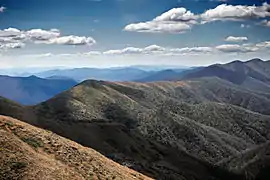 | |
| Highest point | |
| Peak | Mount Kosciuszko, Snowy Mountains |
| Elevation | 2,228 m (7,310 ft) [1] |
| Coordinates | 36°27′S 148°16′E |
| Dimensions | |
| Length | 3,500 km (2,200 mi) North–South |
| Geography | |
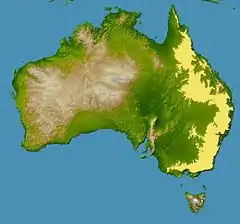 The Great Dividing Range consists of a complex of mountain ranges, plateaus, upland areas and escarpments.
| |
| Country | Australia[2] |
| States/Districts | New South Wales, Queensland, Victoria and Australian Capital Territory |
| Range coordinates | 25°S 147°E |
| Geology | |
| Age of rock | Carboniferous |
The width of the range varies from about 160 km (100 mi) to over 300 km (190 mi).[3] The Greater Blue Mountains Area, Gondwana Rainforests, and Wet Tropics of Queensland World Heritage Areas are located in the range.
Geography
The Dividing Range does not consist of a single mountain range, but is rather a combined complex of mountain ranges, plateaus, hilly upland areas and escarpments with an ancient and complex geological history. The physiographic division name for the landmass is called the East Australian Cordillera. In some places the terrain is relatively flat, consisting of very low hills.[4] Typically the highlands range from 300 to 1,600 metres (980 to 5,250 ft) in height.[4] The mountains and plateaus, which consist of limestones, sandstone, quartzite, schists and dolomite, have been created by faulting and folding processes.[5]
The crest of the Great Dividing Range is defined by the watershed boundary between the drainage basins of river systems east and west of it. The higher and more rugged parts of the "range" do not necessarily form part of the crest of the range, but may be branches and offshoots from it. The term "Great Dividing Range" may refer specifically to the watershed crest of the range, or to the entire upland complex including all of the hills and mountains between the east coast of Australia and the central plains and lowlands. At some places it can be up to 400 km (249 mi) wide.[4] Notable ranges and other features which form part of the range complex have their own distinctive names.
As a rule of thumb, rivers east/southeast of the Dividing Range drain directly eastward into the South Pacific and the Tasman Sea, or southward into the Bass Strait. Rivers west of the Dividing Range drain in various westerly directions according to latitudes: the Murray–Darling basin in southeastern Australia (Darling Downs/eastern South West Queensland, West/Central New South Wales, Northern Victoria and the Murraylands/Riverland region of southeastern South Australia) drain southwestwards into the Great Australian Bight via the coastal Lake Alexandrina;[4] the eastern half of the Lake Eyre basin in east central Australia (the Cooper Creek and Warburton River systems in Central/western South West Queensland and eastern Far North of South Australia) drain southwestwards into the endorheic Kati Thanda–Lake Eyre; the numerous rivers of western Cape York Peninsula in northeastern Australia (North/Far North Queensland) drain westwards or northwestwards directly into the Gulf of Carpentaria.
The sharp rise between the coastal lowlands and the eastern uplands has affected Australia's climate, mainly due to orographic precipitation, and these areas of highest relief have revealed an impressive gorge country.[6] Areas to the east of the mountain range in southern NSW usually experience a Föhn effect, which is a dry wind originating from the Great Dividing Range that abruptly raises the air temperature in the lee of that mountain range and reduces atmospheric moisture.[7] This dry wind, which elevates fire danger in the warm months, occurs because of the partial orographic obstruction of relatively damp low-level air and the subsiding of drier upper-level air in leeward of the mountains. The drier air is then heated more because of the adiabatic compression as it comes down the lee slopes.[8][9][10]
History
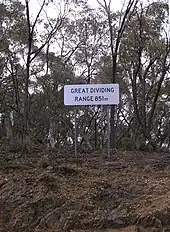
The Great Dividing Range was formed during the Carboniferous period—over 300 million years ago—when Australia collided with what are now parts of South America and New Zealand.[11] The range has experienced significant erosion since. (See Geology of Australia.)
For tens of thousands of years prior to British colonisation the ranges were home to various Aboriginal Australian nations and clans. Evidence remains in some places of their traditional way of life including decorated caves, campsites and trails used to travel between the coastal and inland regions. Many descendants of these nations still exist today, and some remain the traditional owners and custodians of their lands.
After British colonisation in 1788, the ranges were an obstacle to exploration and settlement by the British settlers. Although not high, parts of the highlands were very rugged. Crossing the Blue Mountains was particularly challenging due to the mistaken idea that the creeks should be followed rather than the ridges, and almost impenetrable, labyrinthine, sandstone mountains.[12] Although the most daunting obstacle to western expansion of the colony, the Blue Mountains actually lie to the east of the watershed that divides the Hawkesbury-Nepean system and the Murray-Darling system, the true Great Dividing Range. The watershed in this area lies to the west of Lithgow, passing near the locality of Mt Lambie[13] and village of Capertee.[14] There, as in some other places in New South Wales, the Great Divide is only a slight rise in the surrounding topography.
Knowing that local Aboriginal people had already established routes crossing the range and by making use of Aboriginal walking trails, a usable ridge-top route was finally discovered by Europeans directly westward from Sydney across the Blue Mountains to Bathurst by an expedition jointly led by Gregory Blaxland, William Lawson and William Charles Wentworth.[15][12] Towns in the Blue Mountains were later named after each of these men. This was the start of the development of the agricultural districts of inland New South Wales. A road was built to Blaxland by convicts within six months. Easier routes to inland New South Wales were discovered towards Goulburn to the southwest, and westwards from Newcastle.
Subsequent explorations were made across and around the ranges by Allan Cunningham, John Oxley, Hamilton Hume, Paul Edmund Strzelecki, Ludwig Leichhardt and Thomas Mitchell. These explorers were mainly concerned with finding and appropriating good agricultural land.
By the late 1830s the most fertile rangelands adjacent to the mountain ranges had been explored, appropriated from the traditional inhabitants and some settled. These included the Gippsland and Riverina regions in the south, up to the Liverpool Plains and the Darling Downs in the north.
Various road and railway routes were subsequently established through many parts of the ranges, although many areas remain remote to this day. For example, in eastern Victoria there is only one major road crossing the highlands from north to south, the Great Alpine Road.
Natural components
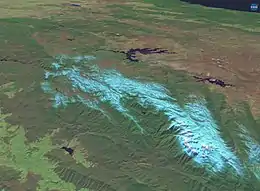
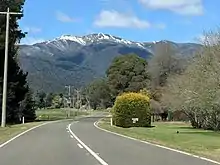
Parts of the highlands consisting of relatively flat and, by Australian standards, well-watered land were developed for agricultural and pastoral uses. Such areas include the Atherton Tableland and Darling Downs in Queensland, and the Northern Tablelands, Southern Highlands and Southern Tablelands in New South Wales. Other parts of the highlands are too rugged for agriculture and have been used for forestry. Many parts of the highlands which were not developed are now included in National Parks.
All of mainland Australia's alpine areas, including its highest mountain, Mount Kosciuszko (2,228 metres or 7,310 feet AHD), are part of this range, called the Main Range.[4] The highest areas in southern New South Wales and eastern Victoria are known as the Australian Alps.
The central core of the Great Dividing Range is dotted with hundreds of peaks and is surrounded by many smaller mountain ranges or spurs, canyons, valleys and plains of regional significance. Some of the major plains include the High Plains of South-Eastern Australia, the Southern Highlands, the Central Highlands and Bogong High Plains of Victoria. Other tablelands considered part of the Great Dividing Range are the Atherton Tableland, Canberra wine region and the Southern Tablelands.
The Dandenong Ranges, Barrington Tops, Bunya Mountains, Blue Mountains, Liverpool Range, McPherson Ranges and the Moonbi Range are some of the smaller spurs and ranges that make up the greater dividing range. Other notable ranges and tablelands which form part of the Great Dividing Range include the Liverpool Range, Mount Royal Range and the Monaro District. Whilst some of the peaks of the highlands reach respectable heights of a little over 2,000 metres (6,600 ft), the age of the range and its erosion mean that most of the mountains are not very steep, and virtually all peaks can be reached without mountaineering equipment.
In some areas, such as the Snowy Mountains, Victorian Alps, the Scenic Rim and the eastern escarpments of the New England region, the highlands form a significant barrier. The eastern escarpment is the site of many spectacular waterfalls which were formed by rivers plunging off the tablelands. In other areas the slopes are gentle and in places the range is barely perceptible.[3]
Well known passes on the range include Coxs Gap, Cunninghams Gap, Dead Horse Gap, Nowlands Gap, and Spicers Gap.
Major cities located on the upland areas of the range include Canberra, Toowoomba and the outer suburbs of Sydney, Melbourne, Brisbane and Cairns in north Queensland. Many towns and cities are located on the range, and also in lowland areas and foothills adjacent to the highlands. There is a strong natural history and cultural attachment to the Dividing Range region in towns and on many, sometimes remote, landholdings. Some of the towns/cities located on the range include:
|
|
|
|
|
Water catchments
.JPG.webp)
The lower reaches are used for forestry, an activity that causes friction with conservationists. The range is also the source of virtually all of eastern Australia's water supply, both through runoff caught in dams, and throughout much of Queensland, through the Great Artesian Basin.
Valleys along the chain of mountains have yielded a water source for important reservoirs and water supply projects such as the Upper Nepean Scheme, Snowy Mountains Scheme and Warragamba Dam.
The Bradfield Scheme has been mooted as a way to transport water from the Wet Tropics of Queensland in the coastal northeast of Far North Queensland via a series of Dams & Tunnels, southwest to inland dryer regions, including a tunnel through the Great Dividing Range into the Flinders River then a tunnel into the Torrens Creek in the White Mountains National Park then flows south into Thompson River / Cooper Creek, part of the Eyre Basin. Many other variations have been proposed.
The Great Dividing Range creates the drainage basins of the Australian south-east coast drainage division and the Australian north-east coast drainage division, whose water flows to the east coast and into the Pacific Ocean, Tasman Sea, and Bass Strait with the westerly Murray–Darling basin which flow inland, away from the coast into the interior plains.
Some of the rivers which flow west of the ranges includes the Condamine River, Flinders River, Herbert River, Lachlan River, Macdonald River, Macintyre River and Namoi River.[2] Rivers that flow north into the Murray–Darling Basin from Victoria include the Goulburn, Mitta Mitta, Kiewa, Ovens, King, Loddon and Campaspe rivers. Rivers that flow east into the Pacific Ocean include the Brisbane River, Burdekin River, Clarence River, Hastings River, Hawkesbury River, Hunter River, Macleay River, Mary River, Richmond River and the Shoalhaven River. Those that flow south, primarily through Victoria, include the Snowy, Cann, Tambo, Mitchell, Latrobe, Thomson, Yarra, Werribee, Hopkins and Glenelg rivers.[3]
Features
At some high hill passes the range provides cool sites appropriate for vineyards.[16]
Railways
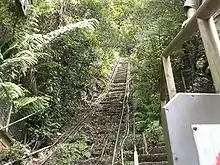
The engineers of early rail passages across the Great Dividing Range needed to find low sections of the range to cross, as well as suitable, "low" gradient paths up the mountains on either side. Rail passages include:
- Townsville-Mt Isa
- Rockhampton-Winton
- Brisbane–Toowoomba (1867) (2.0% gradient)
- Newcastle–Tamworth (c 1870), summit at Ardglen Tunnel (2073' HASL)
- Sandy Hollow to Maryvale Railway Line started in the 1930s to Maryvale (Main Western Railway Line), completed the 1980s to Gulgong (Sandy Hollow–Gulgong Section), summit just west of Ulan - (500M / 1640') The lowest, 4th & last crossing in NSW.
- Sydney–Lithgow (1869), crossing the range via the Blue Mountains (summit near Bell 3507' HASL) (3.00% gradient) [17]
- Sydney–Goulburn (1869), though the divide is actually a few kilometres further west near the crossing with Parkesbourne Road near Cullerin. The next 300 km descending to Wagga Wagga was originally fast, but regrading in the 1920s introduced many curves.
- Melbourne–Seymour, crossing the range near Heathcote Junction (1872) (2.08% gradient)
- Melbourne–Bendigo, crossing the range near Woodend (1862) (1093' HASL)
- Melbourne–Ararat (1875) via Ballarat
Road transport
Many of Australia's highways such as the Alpine Way, Great Alpine Road, Hume Highway, Northern Highway, Melba Highway, Maroondah Highway, Sunraysia Highway, Federal Highway, Great Western Highway, Capricorn Highway, Cunningham Highway, New England Highway, Bruxner Highway, Oxley Highway, Warrego Highway, Waterfall Way, Thunderbolts Way, the Calder Highway, the Western Highway, and the Murray Valley Highway traverse parts of the range.
Protected areas
Much of the range lies within a succession of national parks and other reserves. Most of the national parks are listed below, and there are almost double that amount of state forests.[18][19]


Awards
In 2009 as part of the Q150 celebrations, the Great Dividing Range was announced as one of the Q150 Icons of Queensland for its role as a "location".[20]
References
- "Kosciuszko National Park". Australian Alps National Parks. Australian Government. Retrieved 18 May 2019.
- Australia.gov. "Australian Rocks and Mountains". Archived from the original on 15 July 2012. Retrieved 18 September 2012.
- Shaw, John H., Collins Australian Encyclopedia, William Collins Pty Ltd., Sydney, 1984, ISBN 0-00-217315-8
- Johnson, David (2009). The Geology of Australia. Cambridge University Press. p. 202. ISBN 0-521-76741-5.
- Haggett, Peter (2001). Encyclopedia of World Geography. Marshall Cavendish. p. 3211. ISBN 0-7614-7289-4. Retrieved 23 December 2012.
- Löffler, Ernst; A.J. Rose; Anneliese Löffler; Denis Warner (1983). Australia:Portrait of a Continent. Richmond, Victoria: Hutchinson Group. ISBN 0-09-130460-1.
- Drechsel, S., Mayr, G.J. (2008) Objective forecasting of foehn winds for a subgrid-scale alpine valley. Weather and Forecasting, 23, 205-218.
- Sharples, J.J. Mills, G.A., McRae, R.H.D., Weber, R.O. (2010) Elevated fire danger conditions associated with foehn-like winds in southeastern Australia. Journal of Applied Meteorology and Climatology.
- Sharples, J.J., McRae, R.H.D., Weber, R.O., Mills, G.A. (2009) Foehn-like winds and fire danger anomalies in southeastern Australia. Proceedings of the 18th IMACS World Congress and MODSIM09. 13–17 July, Cairns.
- Hoinka, K.P. (1985) Observation of airflow over the Alps during a foehn event. Quarterly Journal of the Royal Meteorological Society, 111, 199-224.
- Prost, G.; Prost, B. (2017). The Geology Companion: Essentials for Understanding the Earth. CRC Press. p. 98. ISBN 978-1-4987-5609-9. Retrieved 2 February 2020.
- "Crossing the Great Dividing Range—surveying an ancient land". About Australia. Australian Government. 10 December 2008. Archived from the original on 20 December 2011. Retrieved 19 December 2011.
- "Big blue when it comes to the Great Dividing Range". Lithgow Mercury. 24 September 2013. Retrieved 27 February 2020.
- "Capertee - Lithgow Tourism". lithgow-tourism.com. Retrieved 27 February 2020.
- "Gregory Blaxland". Australian Dictionary of Biography. Archived from the original on 1 June 2013. Retrieved 30 May 2013.
- Clarke, Oz (2002). New Wine Atlas: Wines and Wine Regions of the World. Houghton Mifflin Harcourt. p. 300. ISBN 0-15-100913-9. Retrieved 18 December 2011.
- "NSW Railway Altitude Highs and Lows". www.nswrail.net. Archived from the original on 23 October 2017. Retrieved 29 April 2018.
- Melway, Edition 35 2008, Touring Maps
- Brisway, Edition 1, 2005
- Bligh, Anna (10 June 2009). "PREMIER UNVEILS QUEENSLAND'S 150 ICONS". Queensland Government. Archived from the original on 24 May 2017. Retrieved 24 May 2017.
External links
| Wikivoyage has a travel guide for Great Dividing Range. |